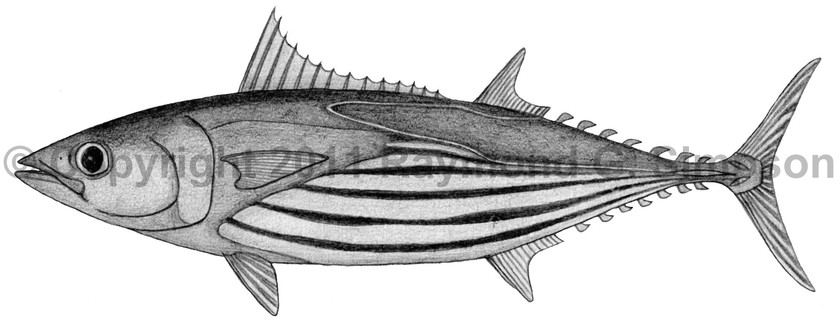
Common Name
Skipjack Tuna
Year Described
Linnaeus, 1758
Identification
Dorsal Fin: XIV-XVI, 12-14, followed by 7-9 finlets
Anal Fin: I, 12-14, followed by 7-8 finlets
Pectoral Fin: 26-27
Gill Rakers: 53-63 (on first arch)
Vertebrae: 41
Body fusiform, elongate, and rounded in cross-section. Snout about twice eye diameter. Adipose eyelid absent. Jaw extends to anterior half of orbit. Teeth small and conical. Tongue with two strong ridges. Two interpelvic processes; shorter than pelvic fins. Dorsal fins separated by a very small gap. Spiny dorsal fin long, with a strongly concave margin. Second dorsal and anal fin small with tall anterior lobes. Pectoral fin short (not reaching end of corselet). Caudal fin semilunate. Corselet well developed; extends posteriorly to second dorsal fin origin. Body naked apart from corselet. Lateral line with a weak anterior arch. Two small caudal keels with a larger median keel in between them.
Color
Body bright silvery below and steel blue to blue-green above. A series (usually 5) of dark stripes on the scaleless portion of the rear body. The fins are dusky to dark blue.
Size
Maximum size to 100cm FL. Commonly under 80cm FL.
Habitat
Pelagic over deep waters (usually not near shore). Forms large schools.
Range
Widespread from New England to Argentina, including the Gulf of Mexico and the Caribbean Sea.
References
Collette, B.B. 2002. Scombridae (pp 1836-1857). In: Carpenter. 2002. The living marine resources of the Western Central Atlantic. Vol. 3: Bony fishes part 2 (Opistognathidae to Molidae), sea turtles and sea mammals. FAO Species Identification Guides for Fisheries Purposes. American Society of Ichthyologists and Herpetologists Special Publication No. 5.
Froese, R. and D. Pauly. Editors. 2011.FishBase. World Wide Web electronic publication. www.fishbase.org
McEachran, J.D. and J.D. Fechhelm. 2005. Fishes of the Gulf of Mexico. Volume 2: Scorpaeniformes to Tetraodontiformes. University of Texas Press, Austin. i-viii +1-1004.